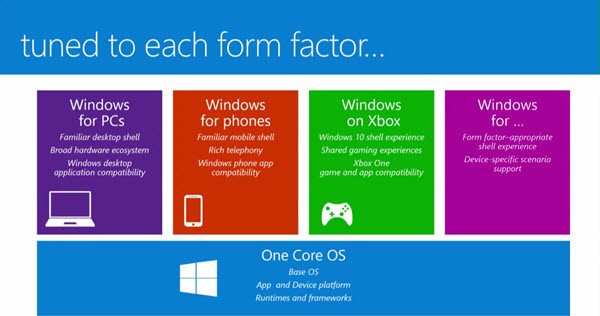Microsoft has released a PowerPoint presentation that will help common users and developers understand how it is going to be with Windows 10. The initial slides suggest that there will be just one Windows 10 instead of Windows Home, Windows Student etc. There will be Windows 10 for device families instead of Home, Student, Pro etc versions.

The Journey To One Windows
Microsoft had hinted about Standard edition and Enterprise edition in its previous press notes. So we can expect that instead of Windows 10 Home edition or Pro edition, there will be Windows 10 for different device categories: IoT; mobile; PCs, etc. as described below.
The presentation suggest that Windows 10 will have six varients:
- Devices and IoT (the bare minimum Windows 10 to support Internet of Things)
- Windows phone (feature rich depending upon the type of hardware available)
- Windows Standard for PCs, laptops, convertibles etc
- Windows for Hololens
- Windows for Xbox
- Windows for Surface Hub, a huge screen that has multiple user input useful in meeting rooms and classrooms.
The next few slides show how the approach to using Windows 10 will be uniform. There will be just one marketplace for all the Windows related apps so that users need not get confused as to from where to download apps for their devices. These are followed by slides that show how Windows 10 uses a consistent approach for all platforms as well. With a consistent platform, multiple device families will support common interface, common natural inputs, common toolset for developers, a common marketplace and again common APIs for developers of Windows apps. In short, Windows 10 will be tuned to each form factor.

The remaining part of the Microsoft presentation talks to app developers as how to develop apps that will interact with Windows 10.
In the presentation, it has used the term Windows Apps for Windows Universal Apps. Thus Metro apps or Modern apps or Windows Store apps or Universal apps will now go by the name of the Windows Apps
Since there will be a common toolset and common API for Windows 10, app developers need not create different versions of their apps. One app will be sufficient for all types of devices: mobile phones, desktops and tablets etc. Developers need not worry about what platform to choose as single platform service will make sure their apps get maximum visibility and run across all types of device families: IoT; mobiles; PCs etc.
Coming to apps on Windows 10, the apps will communicate via API with Windows 10 which, in turn, communicates with the underlying DDI (entry point for device drivers). Then the DDI will pass on instructions to device drivers. All these actions, when bundled into a program (or Windows app), will run on any Windows device family such as PCs, mobiles, tablets etc. because the API would be common to all device families.
The further you go into the presentation, the more it talks about the facilities being provided by Microsoft to app developers, so that they can create Windows apps easily. For example, it lists that Visual Studio will provide IDE, build tools and Windows SDK. Developing Windows universal drivers will make sure the app can be deployed on all Windows 10 devices.
You can check the entire Microsoft presentation here using PowerPoint Online.
Leave a Reply